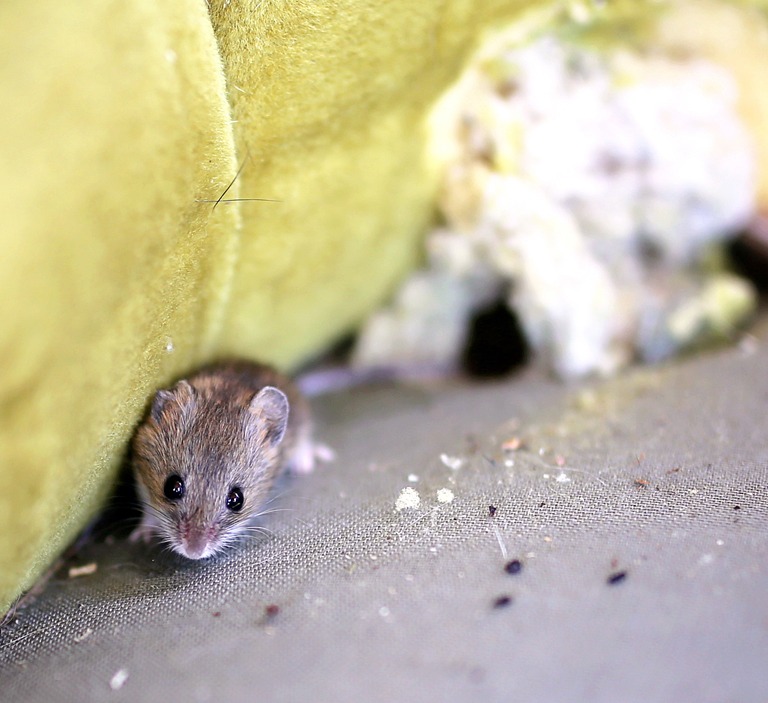You’re finally getting around to cleaning out the kitchen junk drawer (It’s ok, we all have that drawer.) and you see tiny brown pellets amongst the straw wrappers and expired coupons. That can’t be mouse droppings, can it?
Finding mouse droppings anywhere in your home is unsettling. The first step is confirming they are, in fact, mouse droppings. You’ll also need to understand the potential health hazards they carry so you can safely clean the area and work on prevention. This article will help you every step of the way, so let’s dive in.
Is it Mouse Poop? How to Make a Positive Identification
Mouse droppings are small, usually only about one-quarter of an inch in length and resemble a grain of rice. They’re black when fresh and eventually turn a dark brown color. Keep that in mind because that will help you figure out how long you’ve had a mouse problem and the extent of the situation. If the droppings are larger – up to a half-inch long and spindle-shaped – they are more likely from a rat.
Learn about the types of mice in Pennsylvania, New Jersey and Delaware
They Poop That Much? The Frequency of Mouse Droppings
Mice are omnivores who love to snack so it only makes sense that they are also prolific poopers. One mouse will produce up to 50-75 droppings throughout each day. So if your home is visited by more than one mouse, this can lead to a significant amount of waste and potentially harm your health.
Health Hazards of Mouse Poop
Mouse droppings can be carriers of bacteria such as salmonella and viruses like the hantavirus, causing illness in humans. These are transferred to humans on contact or when particles from the droppings are inhaled. Signs of hantavirus include fatigue, muscle aches or fever. If you experience these symptoms shortly after coming into contact with mouse droppings, please seek medical care.
It is important to take extreme care when removing mouse droppings from the affected areas. Wear protective gear like gloves and a mask. Make sure you wash your hands after each contact while avoiding touching your face, mouth, nose or eyes.
Where to Look for Mouse Droppings
The best place to look for mouse droppings is anywhere they might travel on their way to a safe space to nest and seek food. Kitchen cabinets, drawers, and anywhere food is stored should be checked thoroughly. Mice will also tend to leave their droppings near the potential entry points to your home, along walls and in hidden areas like behind appliances.
What’s That Musty Smell? It Might Be Mouse Droppings
Mouse droppings do have a scent but it may not be immediately noticeable. The more droppings that are present, the more pungent the odor. It will be a musty smell and an indication that you may be dealing with a mouse infestation.
Safe Clean-up and Disinfecting of Areas Affected by Mouse Droppings
Because of the probability of harmful bacteria and viruses in the mouse droppings, you need to be very cautious when cleaning and disinfecting the affected areas.
Instead of sweeping them away or using a vacuum, follow these recommendations:
- Ventilate the area. Open windows and doors for at least 30 minutes.
- Wear gloves and a mask to avoid direct contact and inhalation.
- Moisten the droppings with a disinfectant spray to reduce the risk of disturbing the pellets.
- Carefully clean the area, using paper towels to pick up the droppings. Dispose of them in a sealed plastic bag.
- Clean and disinfect the entire area thoroughly.
Prevention and Protection from Infestation
While it’s possible that finding mouse droppings in one location, like a kitchen drawer, is an isolated incident you should still take preventative steps to ensure it doesn’t happen again and doesn’t escalate into an infestation.
Do a regular inspection of your home, looking for droppings. Pay extra attention to the hot spots discussed earlier – potential entry points as well as cabinets and drawers – anywhere mice might access your home and then hide.
If you’re unsure about taking this on yourself, get the peace of mind that comes with regular service from a pest control expert like Moyer. We have several service plans to choose from that will fit your circumstances and your budget.
The best way to remove mouse droppings is to remove the mice. If you are frustrated by setting traps or trying other DIY methods with no success, it’s time to get help from a professional pest control company. Call us at 215.799.2010 or schedule an appointment online.


